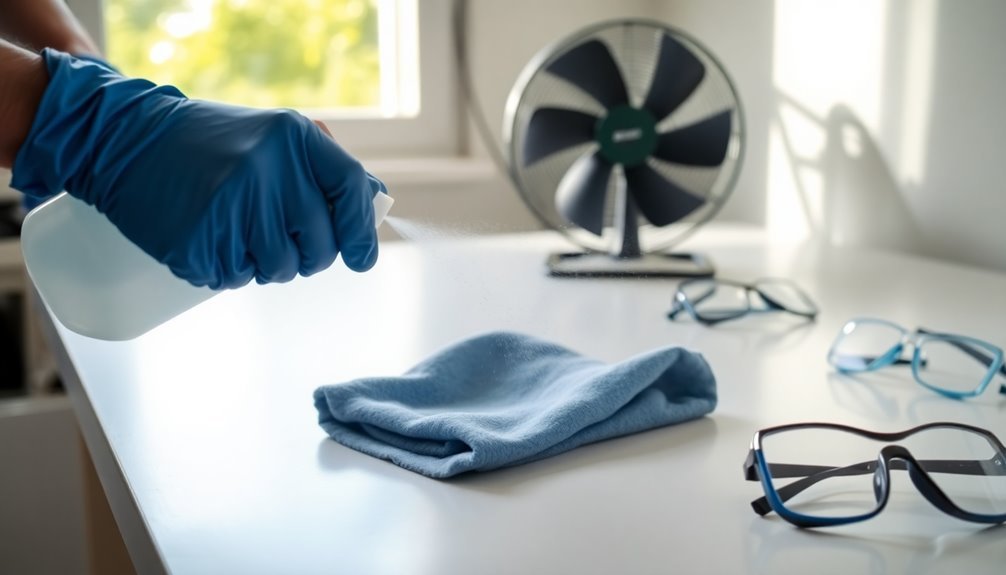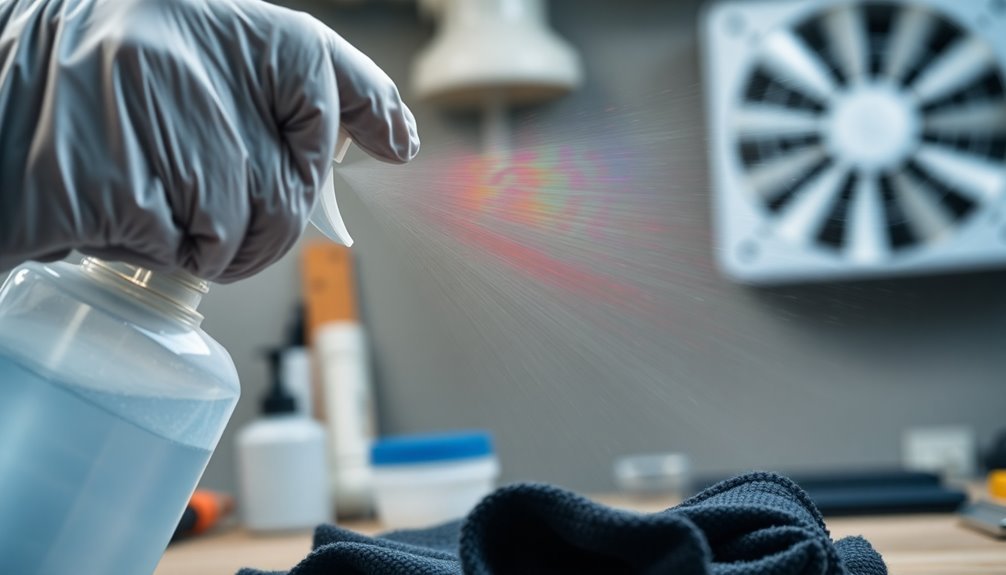When using anti-static spray, you'll need to follow three key safety tips. First, always wear proper protective gear including gloves, safety goggles, and anti-static certified clothing that completely covers your body. Second, make certain you're working in a well-ventilated area with proper air exchange to prevent harmful fume buildup. Third, maintain the correct application distance of 6-8 inches from surfaces and use steady, sweeping motions for even coverage. Following these essential precautions will help protect you from potential hazards, but there's much more to take into account for maximum safety.
Protective Gear Requirements

Three essential pieces of protective gear are required when working with anti-static spray: specialized clothing, gloves, and boots. You'll need to make certain all items meet EN 1149 certification standards to maintain proper static dissipation during use.
Your protective clothing must completely cover any non-anti-static garments underneath, including regular workwear or personal clothing. Studies show static-related failures cause up to one-third of production losses in electronics manufacturing facilities.
When selecting your PPE, you'll want to verify that all conductive materials are properly integrated to create an uninterrupted grounding chain. Your outer garments should cover any non-compliant components like standard zippers or fasteners.
It's vital that your protective gear maintains direct contact with your body or connects to an earthing cable for effective static discharge.
You'll need to check that your PPE incorporates either conductive fillers or appropriate anti-static treatments. Keep in mind that some topical treatments can wear off over time, so you'll want to regularly inspect your gear for effectiveness.
If you're working in critical environments, you may need specialized dissipative clothing that meets additional requirements. Remember that proper grounding through your boots completes the static dissipation circuit, so don't overlook their importance in your protective ensemble.
Proper Ventilation and Storage
Anti-static spray's volatile nature demands careful attention to ventilation and storage practices. When using these sprays, you'll need to work in well-ventilated areas and guarantee proper air exchange systems are in place to remove fumes and particles effectively. Ensuring your workspace has local exhaust ventilation is crucial for minimizing exposure to airborne particles.
Don't inhale the vapors or mists, and make certain you've got emergency procedures ready in case of excessive fume exposure, including quick evacuation plans.
For safe storage, always keep your anti-static sprays in their original containers and store them in cool, dry locations where temperatures won't exceed 50°C/122°F. You'll want to maintain good ventilation in your storage areas to prevent fume buildup and keep the containers away from anything that could ignite them.
Never puncture or crush the containers, even when they're empty.
Since these sprays contain flammable contents under pressure, you'll need to take extra precautions. Don't smoke around the spray or recently treated surfaces, and keep fire extinguishers nearby.
Certify that your equipment is properly grounded, and you're using spark-proof tools. When it's time for disposal, follow local regulations and never reuse empty containers.
Handling and Application Guidelines

The safe application of anti-static spray starts with proper handling techniques and protective measures. Before you begin, put on protective gear including gloves and safety goggles.
You'll need to maintain proper distance from surfaces – about 6-8 inches for general applications, or 9-12 inches for lighter coatings.
Always test the spray on a small, hidden area first to verify compatibility.
When applying, use steady, sweeping motions to achieve even coverage, and don't oversaturate the surface. If you're treating electronic equipment, don't spray directly onto components. Instead, apply the solution to a microfiber towel first, then wipe the surface carefully. The fabric softener component helps prevent static charge buildup while minimizing potential damage to sensitive electronics.
You'll need to follow specific guidelines for different surfaces. Don't use the spray on live electrical equipment, and wait 4-5 minutes after application before operating any treated equipment.
Avoid using it on plasma, LED, or LCD screens, as these surfaces require specialized care.
When working in industrial settings, guarantee all equipment is properly grounded, and maintain appropriate humidity levels in your workspace.
Remember to keep the area well-ventilated throughout the application process to minimize exposure to fumes.
Frequently Asked Questions
How Long Should I Wait Before Touching Surfaces After Applying Anti-Static Spray?
You'll need to wait until the sprayed surfaces are completely dry before touching them. It's vital that you don't handle any treated items until they've fully dried to guarantee maximum effectiveness.
Can Anti-Static Spray Damage Electronic Components or Screens?
Yes, if you don't use it properly, anti-static spray can damage electronics. You'll want to avoid direct application on screens or sensitive components. Instead, spray nearby surfaces and let it dry completely.
What Is the Typical Shelf Life of Anti-Static Spray Products?
You'll typically find that anti-static sprays last up to 6 years when stored properly at room temperature. They'll maintain their effectiveness if you keep them below 50°C and away from direct sunlight.
Are Anti-Static Sprays Effective in All Weather and Humidity Conditions?
You'll find anti-static sprays work best in dry, low-humidity conditions when static is most problematic. While they're still effective in higher humidity, you won't need them as much since moisture naturally reduces static electricity.
How Often Should Anti-Static Spray Be Reapplied for Optimal Performance?
You'll need to reapply anti-static spray every 3-6 months generally, but more frequently on high-use surfaces: daily for work areas, weekly for electronics, and monthly for carpets and furniture, depending on usage intensity.
In Summary
You'll stay safe when using anti-static spray by following these key guidelines: always wear protective gear like gloves and masks, guarantee proper ventilation in your workspace, and handle the product carefully according to label instructions. Store your spray in a cool, dry place away from heat sources, and don't forget to check expiration dates. With these precautions, you can effectively use anti-static spray without compromising your safety.





Leave a Reply